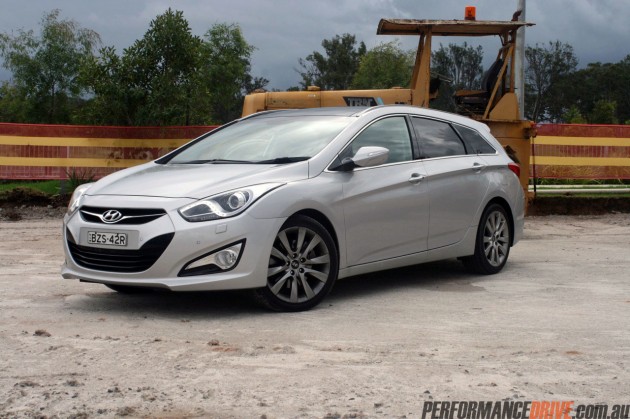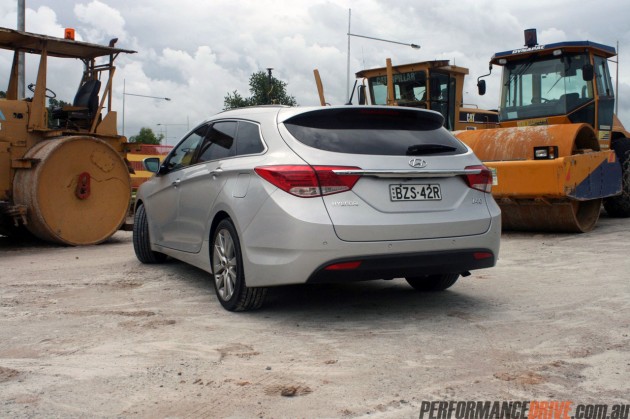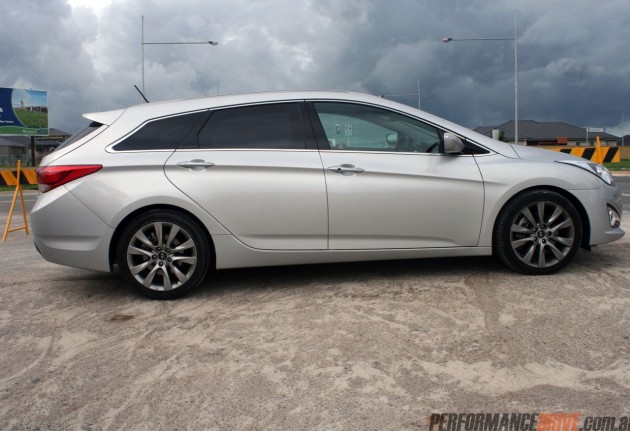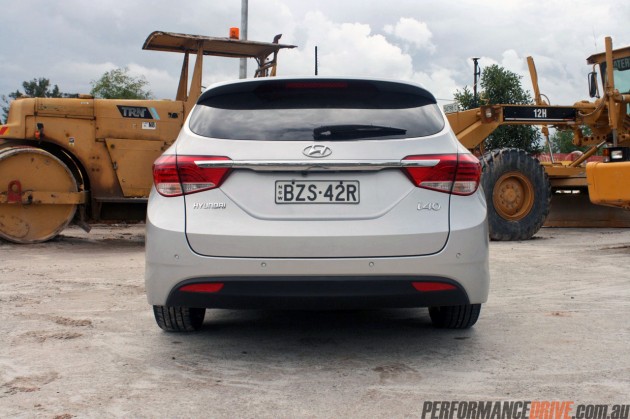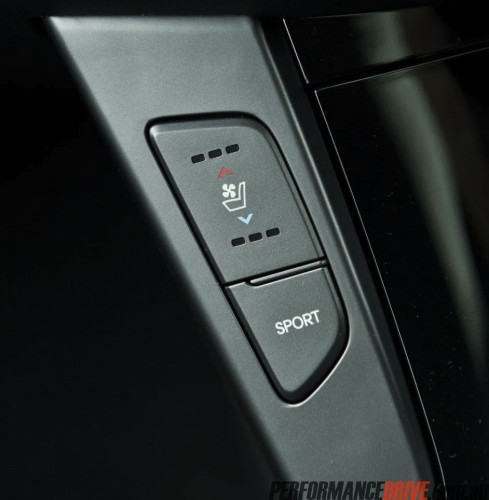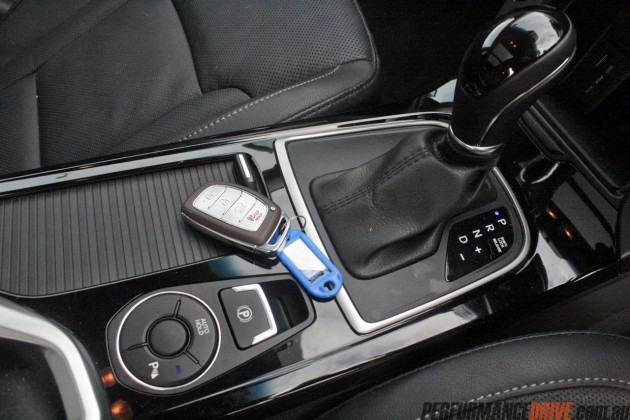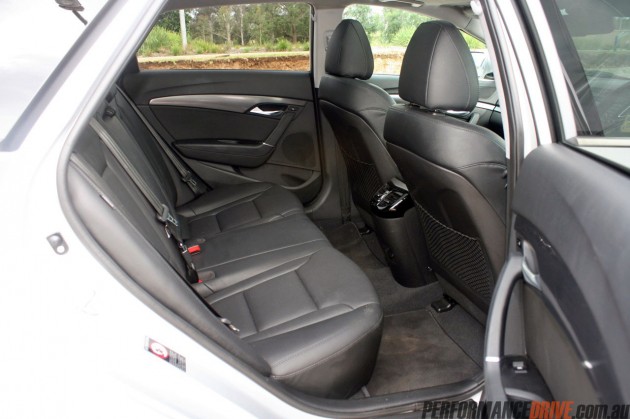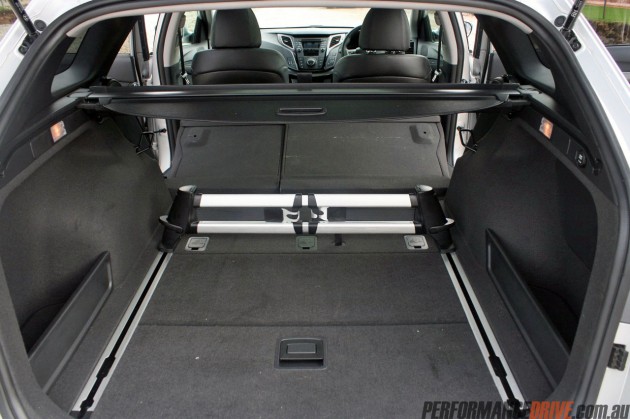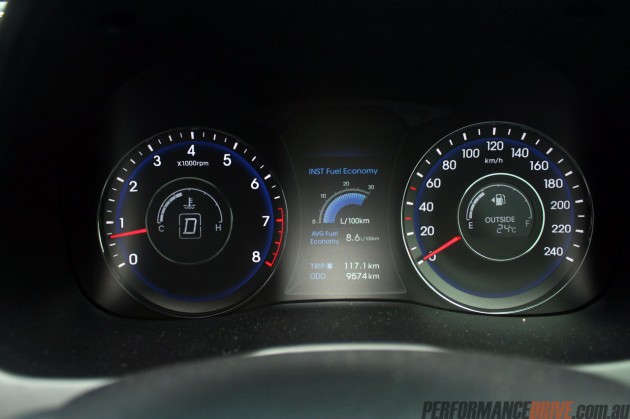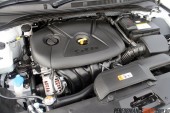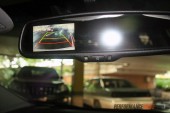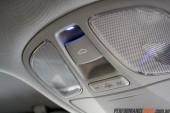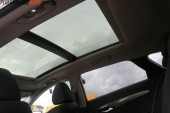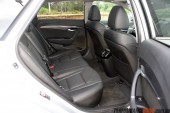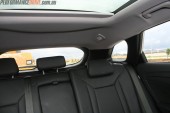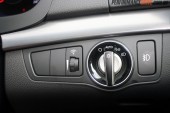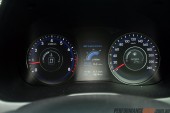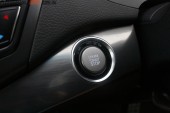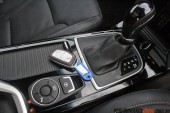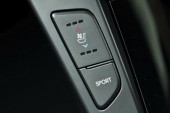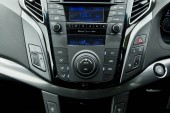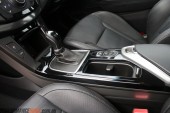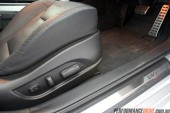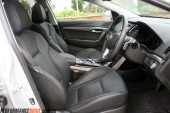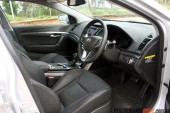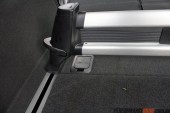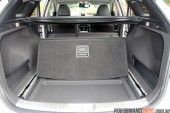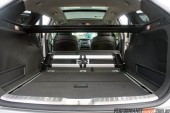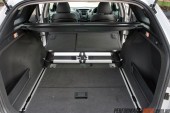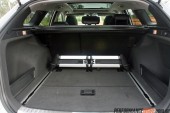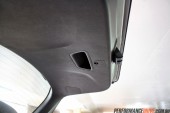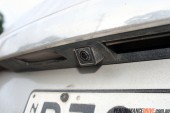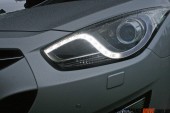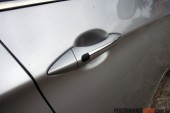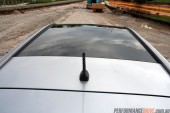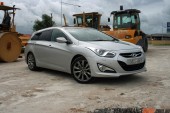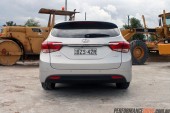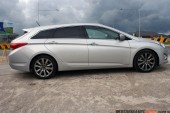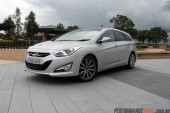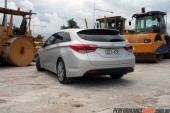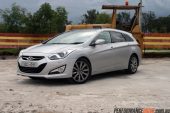It’s not European. It looks like it though, doesn’t it? The 2012 Hyundai i40 Premium is one of the first vehicles to come from the South Korean company to be built specifically targeting the European market.
The i40 is based on the new Hyundai i45/US Sonata platform, and is available in Australia in wagon form only. It comes with either a 2.0-litre four-cylinder petrol with 130kW/213Nm, or a 1.7-litre turbo-diesel with 100kW/320Nm, both available in three trim levels; Active, Elite, and Premium (featured). The Active is the only model available with a six-speed manual or auto, while the rest get the six-speed auto.
Packed with features, the i40 Premium really is a premium vehicle. It comes with electric heated/cooled seats, heated rear seats, a rear-view camera with the display conveniently embedded into the rear-view mirror, keyless entry and start, LED running lights, Bluetooth compatibility with audio streaming, and a full leather interior with electric front seats.
To top it off, the Premium also comes with a cool panoramic glass roof and electric sunroof, as well as HID headlights, and 18-inch alloy wheels. Five-star ANCAP safety has been awarded to all i40 variants, and all come with stability control and traction control, among other safety features, as standard.
2012 HYUNDAI i40 PREMIUM – PROS AND CONS:
PROS:
- Excellent modern design, inside and out; could easily be mistaken for a European car
- Good quality interior materials and touch surfaces
- Full of equipment and features
CONS:
- Steering feel and directness not up there with the competition
- Petrol GDI engine lacks grunt, especially mid-range
- Six-speed auto seems confused at times, making the engine seem even less energetic
2012 HYUNDAI i40 PREMIUM – WHAT’S IT LIKE TO DRIVE:
It all depends on your expectations. Steeping into any Hyundai, you’re either going to have a pre-set negative attitude towards it, because it’s a ‘Hyundai’. Or, you’re going to take the glass half full stance, giving it a go with a ‘not bad for a Hyundai’ attitude.
If you take the latter option, the i40 is a surprisingly fresh and modern drive. The controls and overall character gives off the impression this is a much more up-market vehicle than it is, and it shows Hyundai is continuing its way up in the industry respect rankings.
If you step into it automatically thinking it stinks, because it’s a Hyundai, then may we suggest you wake up and smell the coffee. You might not like it but you will find it difficult to continue swallowing the false pretense that this is a bad thing because of the badge.
There’s no mistaking the 2012 Hyundai i40 is a modern wagon. It feels comfortable, sporty, and very defined, with wafts of quality steaming from all angles, inside and out.
The suspension absorbs country road imperfections very well, and it stays firm enough during cornering, with minimal body roll. The handling is on par with the latest Hyundai products, and it puts up a good performance against the Japanese rivals.
The steering doesn’t give you the most direct feel in the this market segment, but it’s certainly nothing to cry about. And for most buyers of this type of vehicle, sporty and active driving is likely the furthest thing on the to-do list.
That said, can the i40 be taken as a sports wagon and driven as a sports wagon, ready for weekend trips away and a little performance driving?
When pushed, there’s no immediate hint of understeer, and if you keep pushing it, you’ll slowly and progressively feel the front tyres letting you know you’re getting near the limit. And then the switchable stability control kicks in to save the day.
The chassis feels quite ‘chuckable’ too, and light on its feet. It could be just the wagon proportions at the back, but you feel that, if on a track, a bit of a Scandinavian flick could get the tail out in an active, playful manner very easily.
If we had a criticism to the suspension, it’s when carrying a full load. The rear suspension in particular acts like a seesaw over bumps. We recommend a heavy-duty shock absorber setup might be best suited if you’re planning on doing some light towing/camping or plan on carrying four or five adults on a regular basis. No such problems exist when driving with relatively light loads.
Almost all vehicles these days are fitted with excellent brakes. The 2012 Hyundai i40 is no different. They provide powerful and repeatable stopping performance. The i40 comes with a six-speed automatic transmission with paddle shifters behind the steering wheel too; hitting the negative paddle on the left during braking does add to the experience of slowing the car, and makes you feel like a bit of a racing driver.
Unfortunately, there is two letdowns on the driving front. It’s only two, but they’re quite big.
The first is the 2.0-litre naturally aspirated four-cylinder engine, with GDI direct injection. It is only a family wagon, but that 130kW is a glass half empty. The full power is only reached when the engine is screaming (maximum power is achieved at 6500rpm, according to the specs). The 213Nm of torque and its delivery is more worrying though, offering disappointing mid-range pull.
To make matters worse, the transmission doesn’t cater for normal driving very well, even though there are six cogs that the brains behind the auto can choose from.
Say you pull out from a street, the transmission will immediately rush into second and then third, all in an effort to save fuel. This is great for consumption, but not ideal if, for instance, you’ve just pulled out of a street that turns uphill. The transmission will stay in second or third, leaving you in a less-than-pleasant bogged-down state of steady propulsion.
You need to push the pedal to the floor to provoke a downshift, or flick the negative paddle shifter. We think a bit more refinement could be engineered into the transmission’s computer to adapt to varying loads and situations.
To get around this, there is a Sport button on the centre fascia. Once selected, the transmission will hold revs higher and kick down quicker, but it ends up revving a bit too high on settled speeds.
We feel all this is part the transmission’s fault, but also the engine; if the engine made better use of the torque and spread it further along the rev range, it might be able to carry through with the frequent upshifts.
2012 HYUNDAI i40 PREMIUM – INSIDE SPACE AND COMFORT:
This section of the review is where the 2012 Hyundai i40 Premium really shines. There’s so much kit and goodies in the Premium variant, you feel like you’re being pampered the entire drive.
There’s a huge glass roof for starters, with the frontward glass panel doubling as an open/shut electric sunroof. When the blinds are open, it provides a full skylight alfresco environment. It makes the cabin feel larger and brightens up the interior design, beaming light on otherwise shadowed areas you may not notice, such as the nicely designed rear door tilted bottle holders, and the piano black trimming around the entire centre console.
All the controls are laid out in a user-friendly manner, however, you might want to just sit in it for a little while to familiarise yourself with everything. The auto-hold hill start control button and the parking distance control button is located down near the electric switch-operated handbrake, while most other functions are on the centre fascia of the dash.
Five adults can fit in the i40 with acceptable levels of comfort, and there’s plenty of rear legroom for its class. At the end of the centre console there are air-conditioning vents to keep rear passengers cool, while the six-way electric front seats provide good lateral support and comfort.
The cargo space in the rear is large enough to swallow plenty of nicknacks, with an adjustable divider running across the floor to keep loose objects from floating around. The cross bar is also a mounting point for child seatbelts. Available boot space on offer is 553 litres, or 1719 litres with the rear seats folded down.
The floor of the boot also contains shallow storage boxes, and side boxes are in the sides for smaller objects, while there’s also a removable blind that can be pulled across the entire cargo area to conceal your belongs from external view.
2012 HYUNDAI i40 PREMIUM – IS IT A WINNER:
The 2012 Hyundai i40 Premium is definitely a winner. Sure, the petrol engine and drivetrain package won’t blow your socks off, but as a quibble, it’s only going to be concerning for some. There’s no decision-changing setbacks in any area of the vehicle. Seats and comfort, fuel consumption – we averaged slightly higher than official rating (8.6L/100km vs 7.7L/100km) – and those looks are all well into the class standards.
However, the whole point to buying a Hyundai is value for money and market entry prices. We fear, for better or worse, Hyundais have moved up and forward so much so that they are no longer cheap. They are simply another quality proposition.
Pricing for this Premium variant kicks off at $44,490, which puts it on par with a Subaru Liberty Sport Premium wagon and Volkswagen Passat wagon, and around $9000 more expensive than the Mazda6 Diesel wagon – check the rest of the rivals at the bottom of this page.
Like all vehicle buying decisions, we recommend taking the key rivals for a test drive to see what best suits you. The Skoda Octavia RS wagon comes with the 147kW Golf GTI petrol engine, and is the most powerful, while the Ford Mondeo wagon and Mazda6 wagon are the cheapest rivals, starting at $32,840 and $34,750 (i40 Active kicks off at $32,490).
As an overall package, the Hyundai i40 is one of the best looking and feature-packed models available. If you can get over that minor powertrain drawback, go for it.
2012 HYUNDAI i40 PREMIUM SPECIFICATIONS:
MODEL
2012 Hyundai i40 Premium
ENGINE
2.0-litre, four cylinder
ENGINE SIZE (cc) / COMPRESSION RATIO
1998cc / 11.5:1
BORE X STROKE (mm)
81mm x 97mm
POWER
130kW@6500rpm, 213Nm@4700rpm
POWER TO WEIGHT RATIO
11.88: 1 (kg:kW)
WEIGHT
1595kg
HEIGHT / WIDTH / LENGTH
1470mm / 1815mm /4770mm
DRIVETRAIN
Six-speed automatic, front-wheel drive
BRAKES
F: ventilated discs, single-piston calipers
R: discs, single-piston calipers
WHEELS
F and R: 18 x 8 inch, 225/45 R18
FUEL TANK CAPACITY
70 litres
FUEL CONSUMPTION
Tested combined average: 8.6L/100km
Official combined average: 7.7L/100km
PERFORMANCE
0-100km/h: 10.1 seconds (tested)
PRICED FROM
$44,490 (Premium), $32,490 base model
WARRANTY
Five-year/999,000km
THE COMPETITION
Mazda6 Diesel wagon – $35,950, 2.2TD, 136kW/400Nm – or $34,750, 2.5i, 125kW/226Nm
Ford Mondeo wagon – $41,240, 2.0TD, 120kW/340Nm
Subaru Liberty wagon – $45,490, 2.5i, 123kW/229Nm
Peugeot 508 Touring – $45,990, 2.0TD, 120kW/340Nm
Skoda Octavia RS wagon – $41,790, 2.0T, 147kW/280Nm – or various wagons from $26,990 to $43,790
Volkswagen Passat wagon – $40,990, 1.8T, 118kW/250Nm – or $45,990, 2.0TD, 125kW/350Nm
